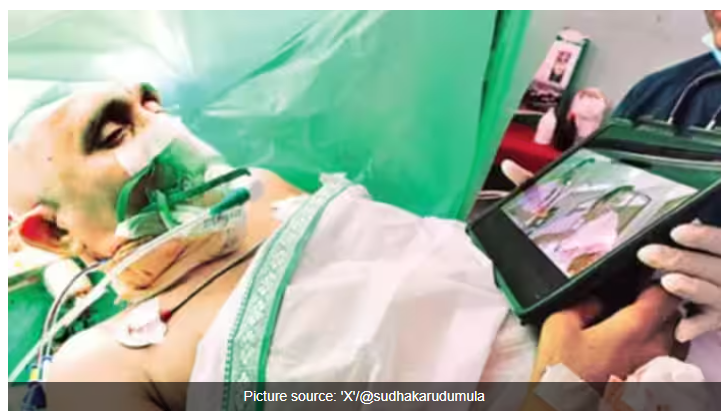
Kakinada, 20 September : In a groundbreaking surgery, doctors at a government hospital in Kakinada, Andhra Pradesh, successfully performed a complex awake craniotomy, keeping the patient awake as she watched a film featuring popular Telugu actor Jr NTR.
The surgery, which took place at the Government General Hospital (GGH), has gained widespread attention after a video of the procedure went viral, showcasing the innovative approach and the calming effect of the film on the patient.
The patient, 55-year-old A. Ananthalakshmi, was diagnosed with a brain tumor following symptoms of numbness in her limbs and persistent headaches. After thorough evaluation, doctors discovered a 3.3 x 2.7 cm tumor on the left side of her brain, requiring urgent surgical intervention.
To perform the surgery, the medical team used the awake craniotomy technique, which allows patients to remain conscious during the operation. This method enables doctors to monitor the patient’s neurological functions in real-time while carefully removing the tumor. To help the patient stay relaxed, scenes from her favorite Jr NTR film, *Adhurs*, were played during the two-and-a-half-hour procedure.
The surgery was a success, with the tumor completely removed while the patient remained awake and engaged with the film. The innovative approach, captured in a video shared by social media user Sudhakar Udumula, has drawn praise for both the surgical team’s expertise and the creative use of entertainment to keep the patient calm.
Doctors Successfully Perform Brain Surgery While Showing Patient NTR’s ‘Adhurs’ Movie
Doctors at the Government General Hospital (GGH) in Kakinada successfully removed a brain tumor from a female patient through “Awake Craniotomy” while showing her favorite movie, Adhurs,… pic.twitter.com/ZKw81PUpUa
— Sudhakar Udumula (@sudhakarudumula) September 18, 2024
What is Awake Brain Surgery?
Awake brain surgery, also known as awake craniotomy, is a procedure performed while the patient is awake and alert. It is primarily used to treat neurological conditions such as brain tumors or epilepsy, allowing surgeons to monitor critical functions during the operation.
Why is the Patient Awake?
The patient remains conscious during surgery to help the medical team avoid damaging key areas of the brain responsible for vision, movement, or speech. Your responses during the procedure help your surgeon ensure they are treating the correct area, lowering the risk of damage to functional regions.
When is Awake Craniotomy Necessary?
This technique is used when the tumor or epileptic focus is located near essential brain areas. If the sections controlling vision, motor skills, or speech are at risk, being able to communicate with the patient during surgery helps the surgeon pinpoint and protect these vital regions.
How Does the Surgery Work?
During the procedure, the patient is lightly sedated but remains awake. The surgeon may ask the patient to answer questions or perform simple movements, ensuring that no damage occurs to important brain pathways. This real-time feedback minimizes risks and helps the surgeon precisely target the affected area.
Why It’s Done
Awake brain surgery is performed when a tumor or seizure-causing section of the brain needs to be removed. The procedure helps the surgeon avoid affecting regions responsible for language, speech, and motor skills. Since these areas can be difficult to pinpoint before surgery, awake craniotomy ensures the surgeon accurately identifies and avoids them, significantly reducing the risk of impairing critical functions.






